As the year turns towards its last quarter, updates on the English, Scandinavian and German publication front, and some delays in the francophonie…
Cinebook goes viral
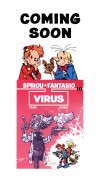 The “Coming Soon” announcement in The Dictator and the Mushroom (Spirou & Fantasio #7) from Cinebook reveals that the next album in English will be Tome & Janry’s Virus (Spirou & Fantasio #33). Cinebook thereby jumps back by ten albums, from Tough Luck Vito (Spirou & Fantasio #43) to Tome & Janry’s very first, which the publisher skipped when it started publishing the series. Virus is one of their best, but references several of Franquin’s albums that Cinebook hasn’t got to yet: La Repaire de la murène (Spirou & Fantasio #9, “The Lair of the Moray”), Le Voyageur du mésozoïque (Spirou & Fantasio #13, “The Traveler from the Mesozoic”) and Les Hommes-bulles (Spirou & Fantasio #17, “Spirou and the Bubble Men”). No release date is given, but expect it sometime in 2016.
The “Coming Soon” announcement in The Dictator and the Mushroom (Spirou & Fantasio #7) from Cinebook reveals that the next album in English will be Tome & Janry’s Virus (Spirou & Fantasio #33). Cinebook thereby jumps back by ten albums, from Tough Luck Vito (Spirou & Fantasio #43) to Tome & Janry’s very first, which the publisher skipped when it started publishing the series. Virus is one of their best, but references several of Franquin’s albums that Cinebook hasn’t got to yet: La Repaire de la murène (Spirou & Fantasio #9, “The Lair of the Moray”), Le Voyageur du mésozoïque (Spirou & Fantasio #13, “The Traveler from the Mesozoic”) and Les Hommes-bulles (Spirou & Fantasio #17, “Spirou and the Bubble Men”). No release date is given, but expect it sometime in 2016.
Zoom to Norway, bringing Tome & Janry collected edition
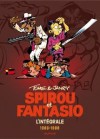 The Danish publisher Zoom has announced that it will expand into Norway in 2016, in collaboration with the bookstore chain Outland. Zoom publishes the Spirou & Fantasio collected editions in Denmark and Sweden (under the brand Mooz), and will now offer these in Norway as well. (Zoom only holds the license to the intégrale books; new albums are still published by Egmont in Norway and Sweden, and by Cobolt in Denmark.) Zoom also announced that the next volume, the second of the Tome & Janry era (1984–1987), is planned for spring 2016. Assuming the Norwegian branch is set up by then, it should be available throughout Scandinavia.
The Danish publisher Zoom has announced that it will expand into Norway in 2016, in collaboration with the bookstore chain Outland. Zoom publishes the Spirou & Fantasio collected editions in Denmark and Sweden (under the brand Mooz), and will now offer these in Norway as well. (Zoom only holds the license to the intégrale books; new albums are still published by Egmont in Norway and Sweden, and by Cobolt in Denmark.) Zoom also announced that the next volume, the second of the Tome & Janry era (1984–1987), is planned for spring 2016. Assuming the Norwegian branch is set up by then, it should be available throughout Scandinavia.

Houba Chop!
 Staying in Denmark, Cobolt lists the upcoming publication of a Marsupilami album by Franquin, under the Danish title Spirillen: Huba! En kærlighedshistorie (Marsupilami Special, “Houba! – A Love Story”). However, readers intrigued by a hitherto unknown Franquin adventure should know that this album, originally published in French as Houba ! Une histoire d’amour, is nothing but a cut-down version of Le Nid des marsupilamis (Spirou & Fantasio #12: “The Nest of the Marsupilamis”).
Staying in Denmark, Cobolt lists the upcoming publication of a Marsupilami album by Franquin, under the Danish title Spirillen: Huba! En kærlighedshistorie (Marsupilami Special, “Houba! – A Love Story”). However, readers intrigued by a hitherto unknown Franquin adventure should know that this album, originally published in French as Houba ! Une histoire d’amour, is nothing but a cut-down version of Le Nid des marsupilamis (Spirou & Fantasio #12: “The Nest of the Marsupilamis”).
Before Marsu Productions got acquired by Dupuis’ parent company, they controlled the rights to Franquin’s Marsupilami work, but not his Spirou & Fantasio albums. So they came up with the brilliant idea of cutting out all the Spirou and Fantasio bits from “Nest of the Marsupilamis”, leaving only the Marsupilami-focused documentary, and publishing that as a “new” Marsupilami album in half-page format. This version also contains other changes: all the narration by Seccotine is removed (with new background filled in where the captions were), rendering the story practically wordless, and some panels have been altered or redrawn, extending them in order to fit the new layout. (The adaptation, retouching and recoloring was done by Catheline and Frédéric Jannin.)
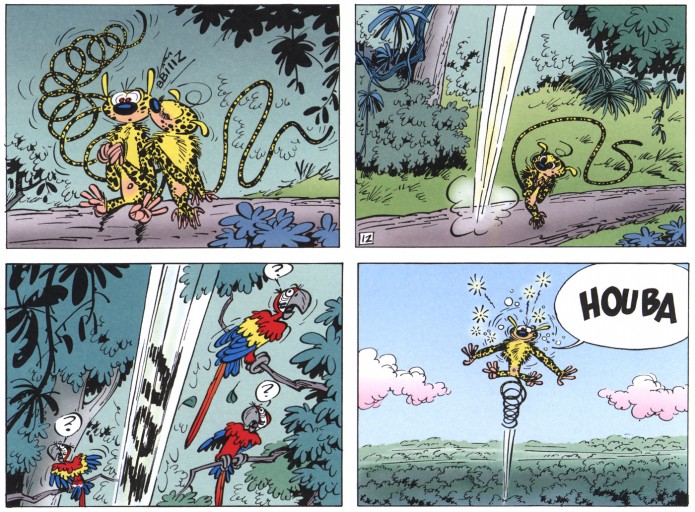
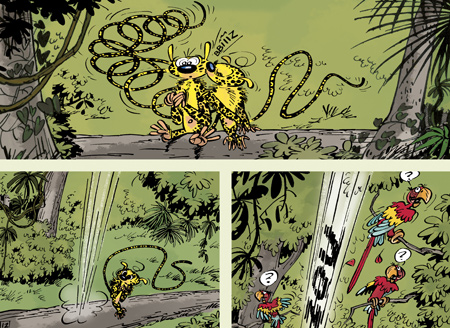
As you might expect, many fans were outraged that Marsu Productions would tamper with a classic in this way after the artist’s death; why Cobolt would want anything to do with it is beyond me. No date of publication is given.
Double Dupuis delays
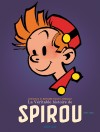
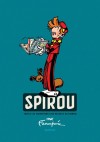 Christelle and Bertrand Pissavy-Yvernault (CBPY) have announced that the second volume of La Véritable histoire de Spirou, 1947–1955 (“The True History of Spirou: 1947–1955”) will be pushed back from its previously scheduled 30. October release to January 2016 (Amazon says the 15th). The work of editing and finalizing the book has taken longer than expected, and although it is now more or less done, there isn’t enough time to have it printed by the original deadline, and closer to Christmas the release schedule is already packed. Note also the change in the cover color, and the period it indicates: previously the dates were given as 1947–1957, but it’s now set to break off two years earlier.
Christelle and Bertrand Pissavy-Yvernault (CBPY) have announced that the second volume of La Véritable histoire de Spirou, 1947–1955 (“The True History of Spirou: 1947–1955”) will be pushed back from its previously scheduled 30. October release to January 2016 (Amazon says the 15th). The work of editing and finalizing the book has taken longer than expected, and although it is now more or less done, there isn’t enough time to have it printed by the original deadline, and closer to Christmas the release schedule is already packed. Note also the change in the cover color, and the period it indicates: previously the dates were given as 1947–1957, but it’s now set to break off two years earlier.
Amazon has also changed its release date for the new collection of Franquin’s covers for the Journal de Spirou digests, Toutes les couvertures des recueils du Journal de Spirou (published under the Franquin Patrimoine series), from 30. October 2015 to 4. March 2016. (The Dupuis site has it listed as 6. March 2015, which is presumably a mistake.)
The other Spirou-related books from Dupuis are still on track, with the collected edition of Jijé’s Spirou comics scheduled for 30. October, and the third edition of Franquin, Chronologie d’une œuvre (“Franquin: A Chronology of His Works”) for 16. October.
Carlsen collection continues
 Finally, Carlsen Comics is putting out the collected edition intégrale books at a decent clip, with the fourth volume due out at the start of December. There is an extremely tedious discussion about the print and paper quality over on the ComicForum, if you have a few hours to waste.
Finally, Carlsen Comics is putting out the collected edition intégrale books at a decent clip, with the fourth volume due out at the start of December. There is an extremely tedious discussion about the print and paper quality over on the ComicForum, if you have a few hours to waste.

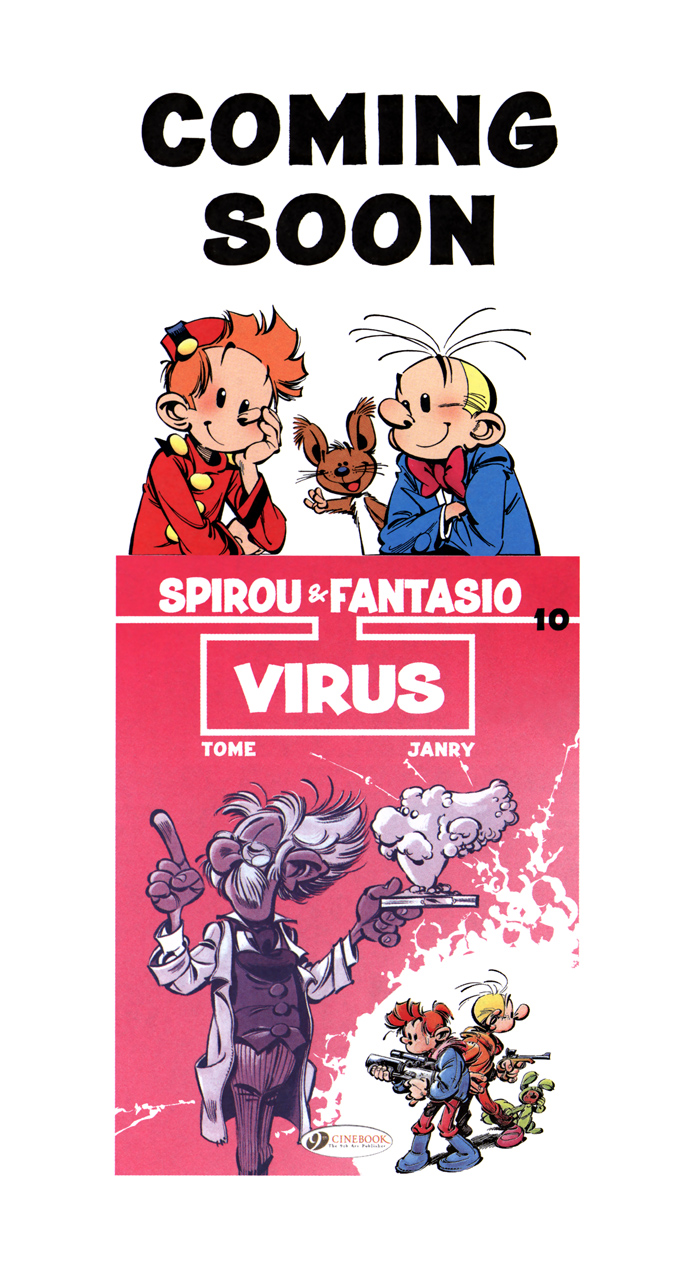
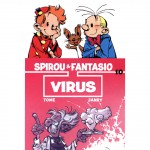
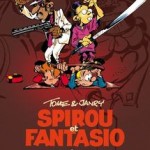


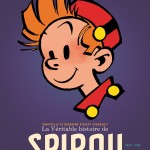
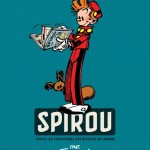


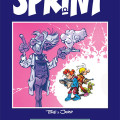
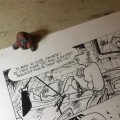
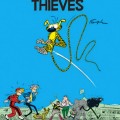
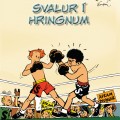

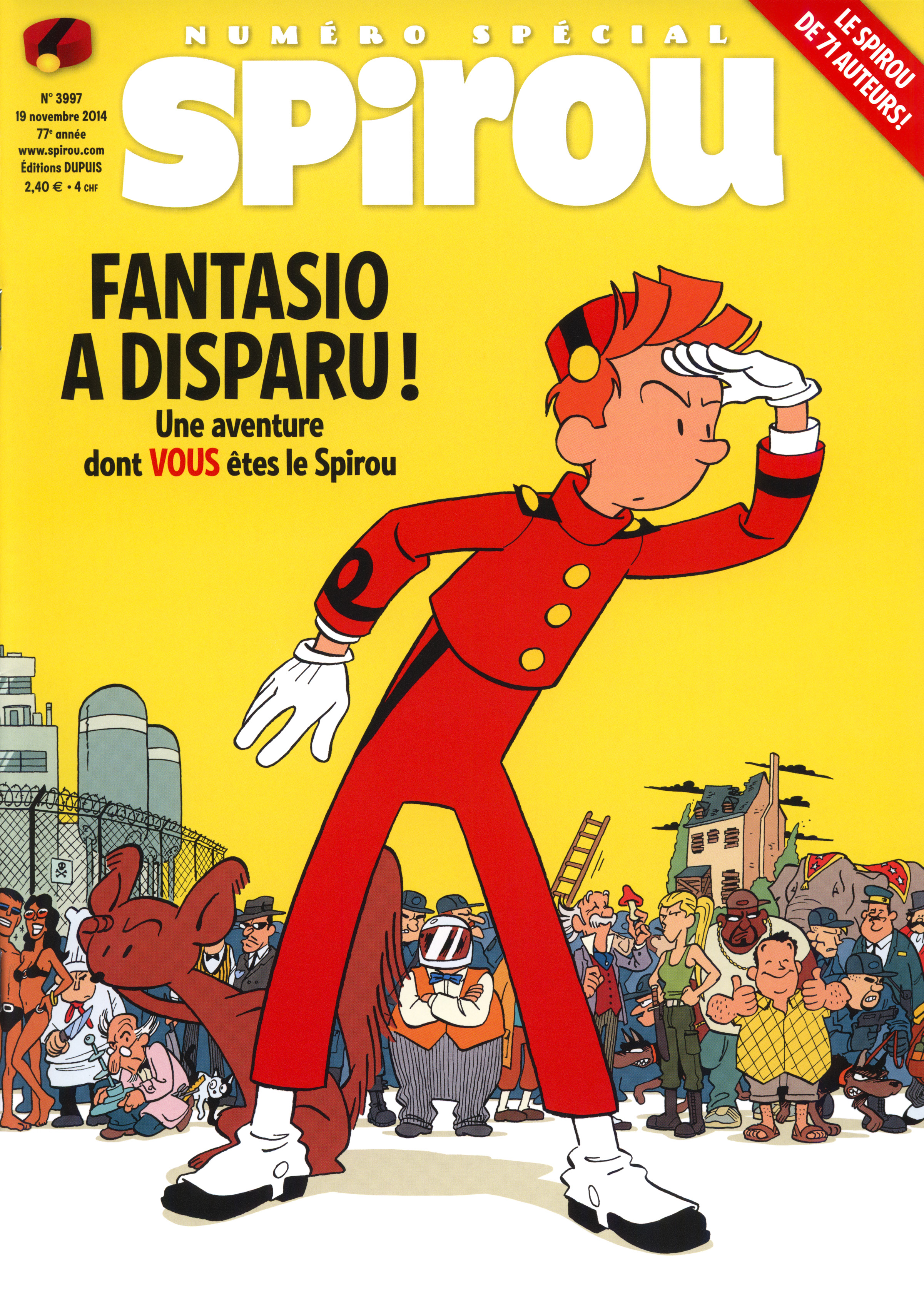
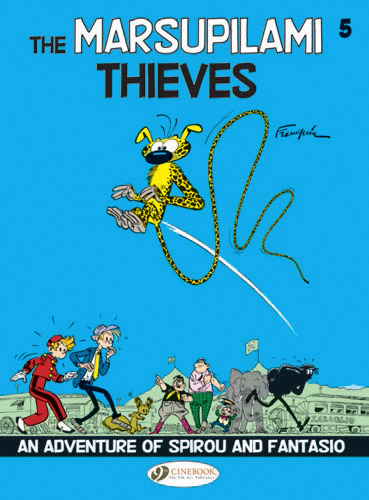
Charlie Aabø liked this on Facebook.
Sarah Joy liked this on Facebook.
Achim Reinecke liked this on Facebook.
Emily Stewart liked this on Facebook.
Daniel Esteve liked this on Facebook.
Amélie Christophe liked this on Facebook.
Zelda Seve Link liked this on Facebook.
Helge Kvingedal liked this on Facebook.
I wonder about the “cover” album for Spirou. For a long time, the cover was mostly three of the four strips of a regular Spirou page, with the top strip being removed for a notice or something by Franquin, with Spirou and Fantasio (mostly) advertising another series in the magazine… Cute, but not so remarkable…
The covers aren’t those for the magazine itself, but for the “digest” collections (recueil / reliure / album du journal), in which a dozen or so issues of the magazine are bound together inside a book cover. During most of the Franquin era, he would draw scenes from the Spirou & Fantasio adventures contained within the book, and later on often a Gaston piece. Many of the Spirou & Fantasio covers have been reprinted and reused for various purposes (e.g. in Scandinavia several have been used as covers for various Spirou albums, instead of the original French ones). Some are used as covers for the collected editions, and most of the others are included within them, though with some pretty heavy Photoshop smudging.
The digest covers were previously published in a big, expensive “VO” edition, but that book was criticized for several reasons. The new book will be smaller and cheaper, and they say it will fix the problems with the last book.
There is also a book under preparation that will collect the masthead illustrations Franquin did for each magazine issue for several years, but it won’t include the rest of the cover.
Stephen Mindykowski liked this on Facebook.
Do you really think ‘Virus’ is one of the best albums by Tomé and Janry? I’m perplexed by that, having always considered it a pretty dull and unentertaining episode, clearly showing a T&J that still needed to hit their stride. I’m not saying it’s a bad-looking story (All the albums by this duo are highly appealing visually) but I really think it has very little going for it, with a boring story, little dialogue of note and no surprises whatsoever (except for the Antarctic setting) and very little comedic value. What makes you like it that much?
I tend to agree… La vallée des bannis, for instance, is a lot better…
It’s not my all-time favorite, but I think it has a lot going for it, and that it’s the best of the ones Cinebook haven’t done yet (and better than several they have).
At heart, it’s a pretty effective action/thriller, with something of a cinematic feel. The intro is one of the few times we see Spirou or Fantasio engage in proper investigative journalism (it’s nice to see Fantasio treated as an actually competent reporter, not just a running joke), while the final showdown in Antarctica provides a suitable climax: shades of Ice Station Zebra or Rucka & Lieber’s later Whiteout – this latter similarity enhanced by a likable, robust female heroine supporting S&F. I don’t think the ending quite lives up to this excellent digest cover, but that’s a pretty high bar:
Overall, the conspiracy plot is far more successful here than in Machine qui rêve, and there’s a sense of proportion: the villains are formidable, but not unbeatable, and it feels realistic that Spirou & Fantasion (and allies) could take them on.
I also think you undersell the humor. Even in just the first few pages, we have stuff like the Marsupilami plushie, the writer modestly correcting John Helena for saying it was “providence” that brought him and Fantasio together, the two muggers (caricatures of Yann & Conrad) asking for a “donation” and Fantasio managing to knock them out, Spirou arriving “undercover” in a magazine van (much like in Alerte aux zorkons), and little amusing details like Spirou dragged out of bed to answer the telephone. All good stuff!
One particular strength of Virus, IMO, is how Tome & Janry make use of elements from the series’ history. The way the Count is involved does justice to his character in a way they never managed to repeat. (Making him a kind of treasure hunter in Aventure en Australie is totally wrong for him, while the later Tome & Janry albums have a tendency to write him out completely, often having him go away at the beginning of the story.) And having the story be about saving John Helena is a big surprise right up front.
I believe my relatively high opinion of Virus is also shared by many fans. In the InediSpirou ranking, the Tome & Janry albums tend to fall into two groups: ones that are quite highly rated (6 albums, from 3.75 to 4.32 stars), and ones with much lower average grades (8 albums, from 2.21 to 3.36 stars). Virus is in the first, “good” group (though the lowest-rated of them), and is the only one apart from Luna Fatale that Cinebook hasn’t published yet. (I don’t agree 100% with this ranking; e.g. I would personally switch Luna Fatale and Vito la déveine, and I think La Frousse aux trousses is rated much too high, but I think it’s relatively reasonable overall.) Comparing it to La Vallée des bannis isn’t really fair, since there’s a pretty strong consensus that it’s Tome & Janry’s best.
Trond Gulvik Larsen liked this on Facebook.
Baka Heo Thi liked this on Facebook.
Frederik Frederik Vauthey liked this on Facebook.
I could have expected a wordy reply, but still thanks. While I could certainly imagine that you liked those elements you mentioned, I must say that I had forgotten all of them except the Count doing science and Fantasio being a serious reporter. Beyond that, none of the things you mentioned had remained in my memory and the overall feeling I had thinking of it is just ‘meh’. Having a former villain show up as an ally of sorts is certainly surprising but then, it doesn’t make him into an interesting character at all and I’m not surprised the canon has not seen him reappear since. I’d consider the album decent but simply not a standout in any way. In the ranking you linked to, I was quite surprised by the places of a few albums. For example, ‘Le Rayon Noir”s theme might be anvillicious, as TV Tropes would say, but I find it a very amusing album despite that and thus a much more enjoyable album overall than ‘Virus’ and others that actually joined it in the bottom ranks. ‘Le jeunesse de Spirou’ on the other hand, I consider a very uneven and chaotic read without much charm and a heavy leaning on nostalgia (I’ll admit really loving the reference to Gaston and Prunelle in the very beginning, though) but that and shoutouts do not a good album make. Nevertheless, it is ranked quite a bit above ‘LRN’. Of course, ratings are always subjective.
Yeah, it’s ultimately a subjective judgment, and no doubt depends on how receptive you were to the album when you first read it.
On my part, I think Le Rayon noir is very weak indeed, in spite of some of Janry’s best art (apart from its anviliciousness, bringing in Vito again feels very lazy and not at all believable – I wonder if that was cross-pollution from the cartoon?), while I have a soft spot for La Jeunesse de Spirou: although it’s obviously very uneven, I enjoy the self-refential humor, and find the two Champignac stories quite successful. Did Tome & Janry come up with the idea of making the shorter stories more tongue in cheek, almost absurd? That feels very right to me. I think if you collected the Yoann & Vehlmann short stories in an album, it would have much the same feel.
María Remersaro García liked this on Facebook.
Inês Santos Saraiva liked this on Facebook.